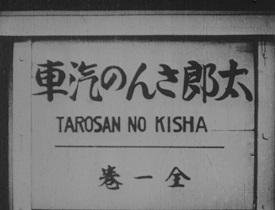Taro's Train: Evaluation of attractive design and running performance

"Taro's Train": The appeal of the 1929 animated film and its historical background■Overview of the work"Taro's Train" is a Japanese animated film that was released in June 1929. This film was released in theaters and is based on an original anime story. It was directed by Yasuji Murata and produced by Yokohama Cinema Shokai. It is a short, one-episode story that takes place over the theme of trains. ■ StoryTaro is a boy who loves trains. When he comes home from school, he gathers his friends and enjoys playing train games. One day, Taro's father gives him a toy train as a gift. That night, Taro is so happy that he dreams about trains. In his dream, Taro becomes a train conductor and takes charge of various incidents that occur on the train. There are passengers who scatter their lunch boxes, slip on banana peels on the aisle and get into fights, and passengers who throw empty cans and bottles out the window. These hit the monkeys working on the track construction, who chase the train with the rail car, and a big fight breaks out on the train. Taro is busy acting as an arbitrator, but the fight causes the train to derail and Taro wakes up from his dream. This story is written in the History of Japanese Animation Films, pages 198-199. ■Explanation"Mr. Taro's Train" is an animated film with a strong message conveying the importance of observing morals on a train. In 1929, manners on public transportation were seen as a problem in Japanese society, and this film was produced as part of raising awareness of this issue. Throughout the story, the film appeals to passengers to observe proper manners in order to have a more comfortable journey. ■ Main staffThe original story and screenplay was by Chuzo Aoji, the illustrations by Yasuji Murata, and the photography by Yukiki Ueno. These staff members played important roles in the Japanese animation industry at the time, and this work was created by them. ■ Historical background and the significance of the work1929 was the year the Great Depression began, and its effects were gradually beginning to spread in Japan. However, the field of animation was still in its infancy, and it was a time when new methods of expression and technology were being explored. Against this backdrop, "Taro's Train" was produced as an educational film to teach children proper etiquette in public places. The film is also an example of the advances being made in Japanese animation technology at the time. In particular, Yasuji Murata's drawings exceeded the technical standards of the time and had a major influence on later animation works. Furthermore, the story development and character portrayal are designed to be easy for children to understand and enjoy. The combination of these elements makes "Mr. Taro's Train" a work that has both educational and entertainment value. ■ Evaluation and influence of the work"Taro's Train" was highly praised when it was released. In particular, the film's educational effects on children drew attention, and it was often shown at schools and homes. This work also had a major influence on later Japanese animated films, particularly on works that dealt with themes of manners in public places, and on the production of animated films aimed at children. Furthermore, the film is also regarded as an example of the advances being made in Japanese animation technology at the time. In particular, Yasuji Murata's drawings surpassed the technical standards of the time and had a major influence on later animation works. The combination of these elements gives Taro's Train a film that has both educational and entertainment value. ■ Detailed analysis of the workThe story of "Taro's Train" unfolds in Taro's dream. In this dream, Taro becomes the conductor of a train and coordinates various incidents that occur on the train. There are fights between passengers who leave their lunch boxes scattered, passengers who slip after throwing banana peels on the aisle, and passengers who throw empty cans and bottles out the windows, which hit the monkeys working on the tracks, who chase the train with a rail car, and a huge fight breaks out on the train. Taro is very busy acting as an arbitrator, but the fight causes the train to derail and Taro wakes up from his dream. This story has a strong message conveying the importance of observing good morals on a train. In particular, actions such as leaving lunch boxes scattered and throwing away banana peels are depicted as symbols of not observing good manners in public places. Additionally, throwing empty cans and bottles out the window can also be interpreted as a message to raise awareness of environmental issues. These actions lead to a huge fight on the train, which then derails, symbolically depicting the consequences of not observing good manners in public places. Also, the scene where Taro is busy acting as a mediator is an important scene to convey the importance of maintaining good manners in public places. Taro tries to resolve an incident on the train as a mediator, but his efforts are in vain and the train derails. This scene functions as a powerful message to convey the importance of maintaining good manners in public places. ■ Appeal and recommendation of the work"Taro's Train" is a 1929 Japanese animated film that is highly regarded as an example of the times and technological advances of the time. It is also garnering attention for its educational effects on children, as it conveys a strong message about the importance of observing morals on trains. Furthermore, the story development and character portrayal are designed to be easy for children to understand and enjoy. The combination of these elements makes "Taro's Train" a work that has value not only as an educational film, but also as entertainment. This work is especially recommended for its educational role in teaching children proper manners in public places. It is also an interesting example of the advancement of Japanese animation technology at the time. Furthermore, the story development and character portrayal are well-crafted to be easy for children to understand and enjoy. The combination of these elements makes "Taro's Train" a work that has both educational and entertainment value. "Taro's Train" is a 1929 Japanese animated film that is highly regarded as an example of the times and technological advances of the time. It is also garnering attention for its educational effects on children, as it conveys a strong message about the importance of observing morals on trains. Furthermore, the story development and character portrayal are designed to be easy for children to understand and enjoy. The combination of these elements makes "Taro's Train" a work that has value not only as an educational film, but also as entertainment. This work is especially recommended for its educational role in teaching children proper manners in public places. It is also an interesting example of the advancement of Japanese animation technology at the time. Furthermore, the story development and character portrayal are well-crafted to be easy for children to understand and enjoy. The combination of these elements makes "Taro's Train" a work that has both educational and entertainment value. "Taro's Train" is a 1929 Japanese animated film that is highly regarded as an example of the times and technological advances of the time. It is also garnering attention for its educational effects on children, as it conveys a strong message about the importance of observing morals on trains. Furthermore, the story development and character portrayal are designed to be easy for children to understand and enjoy. The combination of these elements makes "Taro's Train" a work that has value not only as an educational film, but also as entertainment. This work is especially recommended for its educational role in teaching children proper manners in public places. It is also an interesting example of the advancement of Japanese animation technology at the time. Furthermore, the story development and character portrayal are well-crafted to be easy for children to understand and enjoy. The combination of these elements makes "Taro's Train" a work that has both educational and entertainment value. "Taro's Train" is a 1929 Japanese animated film that is highly regarded as an example of the times and technological advances of the time. It is also garnering attention for its educational effects on children, as it conveys a strong message about the importance of observing morals on trains. Furthermore, the story development and character portrayal are designed to be easy for children to understand and enjoy. The combination of these elements makes "Taro's Train" a work that has value not only as an educational film, but also as entertainment. This work is especially recommended for its educational role in teaching children proper manners in public places. It is also an interesting example of the advancement of Japanese animation technology at the time. Furthermore, the story development and character portrayal are well-crafted to be easy for children to understand and enjoy. The combination of these elements makes "Taro's Train" a work that has both educational and entertainment value. "Taro's Train" is a 1929 Japanese animated film that is highly regarded as an example of the times and technological advances of the time. It is also garnering attention for its educational effects on children, as it conveys a strong message about the importance of observing morals on trains. Furthermore, the story development and character portrayal are designed to be easy for children to understand and enjoy. The combination of these elements makes "Taro's Train" a work that has value not only as an educational film, but also as entertainment. This work is especially recommended for its educational role in teaching children proper manners in public places. It is also an interesting example of the advancement of Japanese animation technology at the time. Furthermore, the story development and character portrayal are well-crafted to be easy for children to understand and enjoy. The combination of these elements makes "Taro's Train" a work that has both educational and entertainment value. "Taro's Train" is a 1929 Japanese animated film that is highly regarded as an example of the times and technological advances of the time. It is also garnering attention for its educational effects on children, as it conveys a strong message about the importance of observing morals on trains. Furthermore, the story development and character portrayal are designed to be easy for children to understand and enjoy. The combination of these elements makes "Taro's Train" a work that has value not only as an educational film, but also as entertainment. This work is especially recommended for its educational role in teaching children proper manners in public places. It is also an interesting example of the advancement of Japanese animation technology at the time. Furthermore, the story development and character portrayal are well-crafted to be easy for children to understand and enjoy. The combination of these elements makes "Taro's Train" a work that has both educational and entertainment value. "Taro's Train" is a 1929 Japanese animated film that is highly regarded as an example of the times and technological advances of the time. It is also garnering attention for its educational effects on children, as it conveys a strong message about the importance of observing morals on trains. Furthermore, the story development and character portrayal are designed to be easy for children to understand and enjoy. The combination of these elements makes "Taro's Train" a work that has value not only as an educational film, but also as entertainment. This work is especially recommended for its educational role in teaching children proper manners in public places. It is also an interesting example of the advancement of Japanese animation technology at the time. Furthermore, the story development and character portrayal are well-crafted to be easy for children to understand and enjoy. The combination of these elements makes "Taro's Train" a work that has both educational and entertainment value. "Taro's Train" is a 1929 Japanese animated film that is highly regarded as an example of the times and technological advances of the time. It is also garnering attention for its educational effects on children, as it conveys a strong message about the importance of observing morals on trains. Furthermore, the story development and character portrayal are designed to be easy for children to understand and enjoy. The combination of these elements makes "Taro's Train" a work that has value not only as an educational film, but also as entertainment. This work is especially recommended for its educational role in teaching children proper manners in public places. It is also an interesting example of the advancement of Japanese animation technology at the time. Furthermore, the story development and character portrayal are well-crafted to be easy for children to understand and enjoy. The combination of these elements makes "Taro's Train" a work that has both educational and entertainment value. "Taro's Train" is a 1929 Japanese animated film that is highly regarded as an example of the times and technological advances of the time. It is also garnering attention for its educational effects on children, as it conveys a strong message about the importance of observing morals on trains. Furthermore, the story development and character portrayal are designed to be easy for children to understand and enjoy. The combination of these elements makes "Taro's Train" a work that has value not only as an educational film, but also as entertainment. This work is especially recommended for its educational role in teaching children proper manners in public places. It is also an interesting example of the advancement of Japanese animation technology at the time. Furthermore, the story development and character portrayal are well-crafted to be easy for children to understand and enjoy. The combination of these elements makes "Taro's Train" a work that has both educational and entertainment value. "Taro's Train" is a 1929 Japanese animated film that is highly regarded as an example of the times and technological advances of the time. It is also garnering attention for its educational effects on children, as it conveys a strong message about the importance of observing morals on trains. Furthermore, the story development and character portrayal are designed to be easy for children to understand and enjoy. The combination of these elements makes "Taro's Train" a work that has value not only as an educational film, but also as entertainment. This work is especially recommended for its educational role in teaching children proper manners in public places. It is also an interesting example of the advancement of Japanese animation technology at the time. Furthermore, the story development and character portrayal are well-crafted to be easy for children to understand and enjoy. The combination of these elements makes "Taro's Train" a work that has both educational and entertainment value. |
<<: The appeal and reviews of "Knot Removal": A fusion of profound themes and visual beauty
Recommend
New version of "The Heaven Sword and Dragon Saber" poster released, Louis Koo, Donnie Yen and others appeared
The poster of the movie "New Heaven Sword an...
Disney admits it can’t handle it anymore? Boba Fett: A Star Wars Story is officially cancelled
According to foreign media reports, Lucasfilm Cha...
The sci-fi thriller "Infinity Pool" released a poster and will be released in North America on January 27
Sina Films reported today (December 17) that the ...
On the 22nd, 523 cinemas across the country resumed work and the box office rose to 41,400 yuan
According to the latest statistics from Maoyan, a...
Apple Japan releases a wonderful animated promotional video: The world of Mac is more exciting
Although Microsoft OS is now everywhere, there ar...
2024 Lunar New Year box office exceeds 500 million, love movie "Good Things" alone accounts for 300 million
According to data from Lighthouse Professional Ed...
Netflix's "Cowboy Bebop" live-action drama IGN scored 7 points, M-station average score is only 39 points
Netflix's live-action TV series "Cowboy ...
Bond 25 director's addiction to PlayStation delayed filming
Update : Bond 25 director Carey Jogi confessed on...
Mayla collaborated with the "NieR" animation to launch high heels with beautiful designs!
Japanese clothing brand Mayla often collaborates ...
The appeal and evaluation of Furiten-kun: A must-read review for anime fans
Furiten-kun - Movie reviews and details overview ...
Sonic the Hedgehog movie poster leaks
The new look of the movie version of "Sonic ...
The appeal and reviews of "To Heart": A moving story and deep characters
"To Heart" - A masterpiece anime depict...
Black Witch Passes!! - A review and recommended points of the fascinating magical world
Black Witch Passes!! - Kuromajosangatooru!! ■ Pub...
Disqualified from Another World: What is the appeal of this new adventure that exceeds expectations?
A comprehensive review and recommendation of Isek...
The domestic release date of the special edition of "Bad Boys for Life" is still to be determined
Today (March 5), Sony Columbia Pictures released ...









